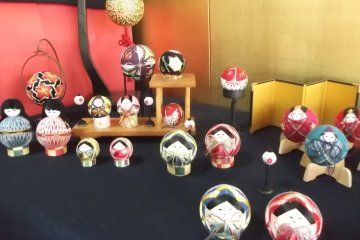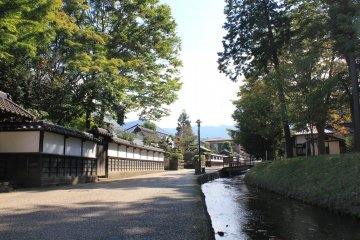With the renewed interest in Japan’s feudal era—take the hit Emmy-winning TV series Shogun or the upcoming PS5-exclusive Ghost of Yōtei both as recent examples—it is no surprise that the spotlight is back on Japan’s rich, textured past more than ever.
Kanazawa City then, with its beautifully preserved Edo-period heritage spanning samurai residences and geisha districts, is a prime candidate worthy of a jaunt across Honshu to the Sea of Japan-facing Ishikawa prefecture. It’s a simple trip from Tokyo too and, since 2015, the extended Hokuriku Shinkansen has brought the journey time up to the coast down to just 2hr 30min by bullet train.
We decided to pay a visit to Kanazawa but, knowing that travel is increasingly tricky without a connected smartphone, wanted to also try out the Japan Wi-Fi auto-connect app (available on iPhone and Android). It promises to make getting around a breeze by keeping you tethered to Wi-Fi wherever possible. Japan already has a lot of free Wi-Fi hotspots operated by different providers, but the app helps remove the middle-man (i.e. you) from the process of having to find and manually connect to them. The app automates connecting to official Wi-Fi hotspots, bringing peace of mind during your travels.
Let's explore Kanazawa and highlight how the app can help you along the way!
Kanazawa Station

The giant wooden Tsuzumi-mon drum gate at the East entrance of Kanazawa Station is a defining symbol of the city and makes both a recommended photo spot and popular meeting place. Take a few snaps of the rising structure against the glass station plaza behind it, while finding your bearings and letting your loved ones know you’ve arrived safely. The station area has 4 Wi-Fi hotspots and, if you ever want to be sure that the city has you covered, you can always reference this map (PDF) in advance too, which is reflected in the app too. Given we’re at the main station, it’s a helpful assist for checking train or bus times—in fact, we decided to catch a bus to reach our next stop.
Omicho Market

Omicho Market, Kanazawa’s largest fresh food market since the Edo Period, is a bustling hub with over 200 shops and stalls. Famous for its fresh seafood, local produce, and speciality items like flowers and kitchen tools, it attracts both locals and tourists. The market is lively in the mornings but becomes especially busy at lunchtime, with many restaurants serving Kanazawa’s renowned seafood rice bowls, creating long queues for a taste of local flavours.
The bus stops on the west side of the market are Wi-Fi zones, so you’ll be able to connect here for free—a good way to look for a nearby restaurant if you’re hungry. We were instantly drawn in by another of the city’s cherished brands: Kanazawa Champion Curry, which helpfully has a branch on the basement floor beneath the main market.

Let’s explore the rest of the city — the downtown area is well-covered by buses, but many places are within walking distance from each other.
Kanazawa’s 3 geisha districts
Higashi Chaya District

The Higashi Chaya District is one of Kanazawa’s largest traditional geisha districts. with an incredible number of well-preserved geisha houses maintaining their distinctive kimusuko-style wooden lattice facade. Though only a select handful still operate as exclusive geisha houses, traditional shops and cafes occupy the remaining buildings which make the area well worth exploring—some visitors even rent kimono for the occasion.

One such traditional shop can be found on the western edge of the district. Hakuichi is a gold leaf crafts shop that specializes in producing gold leaf products, many of which can make the ideal souvenir. Browse the store to find numerous gold leaf-inspired items, from traditional pottery to modern cosmetics. Hakuichi was also the first to launch a gold leaf-covered ice cream (back in 2015 when the Shinkansen arrived). It’s a fun and tasty way to experience this part of Kanazawa, and will probably see you reaching for Instagram to frame the perfect shot.

Gold leaf in Japan is synonymous with Kanazawa, with 99% of Japan’s total production based here and dating back over 400 years. The Kaga Domain (Maeda Clan) that ruled over this Edo-period castle town greatly encouraged the development of traditional crafts—in part to appease a weary shogunate of their growing influence—which has led to the region’s modern reputation for crafts, including ceramics and fabric dyeing, as well as gold leaf.
Kazue-machi Chaya District

West of the Higashi Chaya District you’ll find the stunning riverside Kazue-machi Chaya District. Kazuemachi has its own appeal and calm thanks to the trees, foliage and quieter streets. Together with Higashi Chaya and Kyoto’s Gion, these three geiko (local dialect for ‘geisha’) districts are unique in being designated Important Cultural Properties.

Nishi Chaya District
The Nishi Chaya District, to the south-west of Kenrokuen garden, is the last of Kanazawa’s 3 chaya districts and, while smaller in stature, is compact and commands incredible views from just about any angle thanks to the rows of preserved teahouses.

Kanazawa Castle area
Kanazawa Castle Park
Perhaps the historical centre of the city, Kanazawa Castle Park is home to the remains of Kanazawa Castle and neighbouring Kenrokuen — the former private garden for the castle and now considered one of Japan’s top three gardens.

Since Maeda’s arrival in 1583, the original castle underwent expansion but also suffered destruction several times throughout its history. The present Ishikawa-mon Gate (a National Important Cultural Property) was originally rebuilt in 1788, whereas the Hishi Yagura, Tsuzuki Yagura and Gojukken Nagaya (turrets and storehouse) were restored in 2001. These restorations command a small entrance fee, but other sections of the castle are free.
You can find Wi-Fi hotspots around the periphery at several of the park entrances.
Kenrokuen

Kenrokuen, one of Japan’s “Three Great Gardens,” exemplifies traditional landscape gardening and is a designated Place of Scenic Beauty.
Created in the Edo Period by the Maeda clan who ruled over Kaga province, it was designed to showcase the six ideal qualities of a perfect garden: spaciousness, seclusion, artificiality, antiquity, abundant water, and broad views (Kenrokuen literally means “garden that combines six characteristics.")
The garden is renowned for its seasonal beauty, with cherry blossoms in spring, lush greenery in summer, vibrant autumn foliage, and snow-covered landscapes in winter.
One of its iconic views has to be that of the Kotojitoro Lantern which overlooks Kasumigaike Pond — it can be found a short walk from the Katsurazaka Gate that connects to Kanazawa Castle Park via the Ishikawa-mon Gate.
Nagamachi District

The Nagamachi area is an affluent samurai neighbourhood where wealthy merchants, samurai and their families would live, closer to the protection afforded by nearby Kanazawa Castle than other regions of the city. Pass by canals and stroll along cobblestone streets flanked by earthen walls before, if you have time, visiting Nomura-ke—a restored samurai residence that is open to the public.

Lose your bearings? All of Kanazawa’s traditional streets have their own Wi-Fi hotspots so you’ll never be far from what you need — your device can also auto-notify you each time it connects to a nearby hotspot.
21st Century Museum of Contemporary Art

Just south of the castle grounds, the 21st Century Museum of Contemporary Art is a cutting-edge art space known for its innovative design and regular exhibits.
Opened in 2004, the circular building offers a seamless blend of indoor and outdoor art installations. Renowned for some of its permanent exhibits like Leandro Erlich’s “Swimming Pool,” the museum showcases a diverse range of modern art but also provides a space where Kanazawa’s regional art can connect with future trends and art discourse. The modern space also acts as a cornerstone for the community, thanks to its library and spaces dedicated to children and learning.
In summary
Kanazawa offers rich cultural experiences, beautiful attractions, and convenient access to Wi-Fi hotspots across the city. This well-developed infrastructure ensures that visitors can stay connected and make the most of their time in the city.
Download the Japan Wi-Fi auto-connect app (available on iPhone and Android) to enhance your visit to both Kanazawa and many more Japan destinations on your trip.























